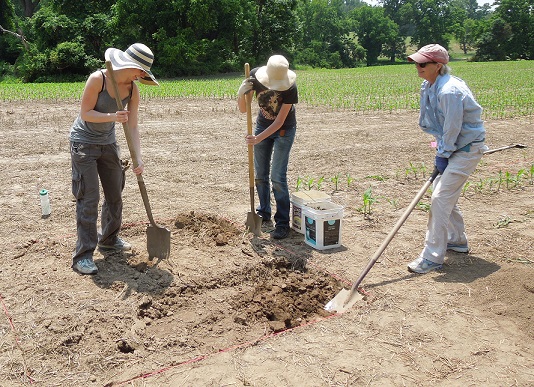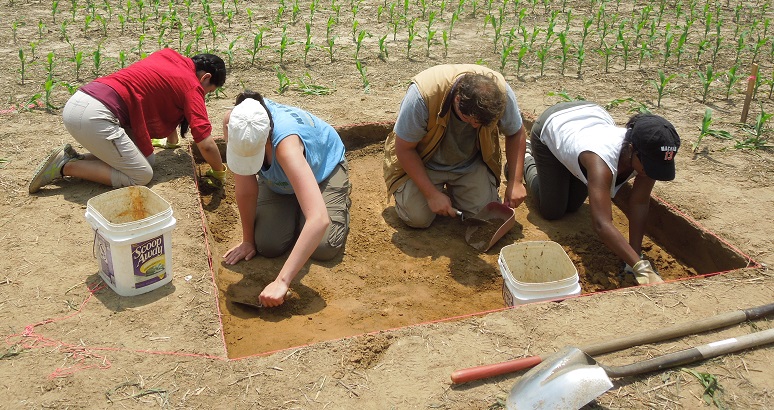Scientists, students, and volunteers unearth late 17th– and 18th-century objects behind Sellman House
by Sarah Hansen
On a sunny June afternoon at the Smithsonian Environmental Research Center, students and volunteers are hard at work in a cornfield behind the Sellman House. Some shovel soil out of pits. Others screen it with giant sieves, looking for artifacts. Still others use trowels to smooth the bottom and sides of the pit, hoping to reveal differences in soil coloration and texture. This scene will repeat every Monday, Tuesday, and Friday from about 9a.m. to 4 p.m. until June 20. Guided by Laura Cripps, acting Chair of Social and Cultural Sciences at Howard Community College, and Jim Gibb, head of SERC’s Archaeology Lab, the group is excavating a site that contains objects and building materials that provide a window into 17th– and 18th-century life.
They’ve found fabric fasteners, clay tobacco pipes, ceramics, oyster shells, clay daub, and “lots of nails,” said Cripps. They’re searching for clues about human activity in and around the house in centuries past. Partly because of a deeply burned area (identified by a large orange-brown blotch in the soil), Cripps thinks this site might have supported slave quarters, an auxiliary kitchen, or even an early iteration of the Sellman House that still stands about 100 meters away.
The type and style of artifacts recovered from the site help Cripps and Gibb determine when settlers occupied the land. Some artifacts, such as pottery and tobacco pipe fragments, can date the site to within about ten years. “Pollen cores,” narrow cylinders of soil that extend several feet into the ground, contain pollen that reveals how settlers used the land – as crop fields or for grazing animals, for example. One of Gibb’s citizen scientists, George Riseling, hopes to start taking pollen cores soon.
But this project isn’t just about pulling nails and chunks of soil out of the ground. One of its larger objectives is to explore how humans have changed the landscape—specifically with regard to erosion and sedimentation. By excavating around Sellman House, near the entrance to the SERC campus, Gibb discovered that sometime in the early 19th century erosion moved a great deal of soil from in front of the house. Because this occurred far from the crop fields, the change couldn’t have been caused by agriculture. The data suggest that daily use of the front yard, as well as building construction and demolition, destroyed ground cover and promoted soil loss.
It’s important to learn how human development and use of the land affects patterns of erosion, because erosion can threaten homes, schools and infrastructure in the present as well. Gibb pointed out that storm water drainage systems and choices about where to build, especially along coastlines, are relevant issues today.
This excavation would not be nearly so far along if not for the students and volunteers who contribute their time and energy to the project. According to Gibb, they’ve helped immeasurably. Some of them are HCC students, encouraged by Cripps to participate in the AURA program (Applied Undergraduate Research in Anthropology). Alice Joy Thomas is a nursing major earning fieldwork credit for her time at SERC. Sarah Grady earned her B.A. in anthropology from the University of Maryland-College Park and then got connected with Gibb by a regular at the restaurant where she waits tables. Now she works as a volunteer at the SERC site and also does paid contract work with Gibb. She wants to go to graduate school and is using this experience to learn techniques and bolster her application.
And then there’s Bruce Birdsell. He’s retired, with no background in archeology or even science, but he loves volunteering at SERC. He smiled as he sifted dirt, breaking up the larger chunks with his fingers. His only complaint: “Why didn’t I do this sooner?”





Loved it, Sarah. What a neat way to determine how we have used the land. I’m reading The Worst Hard Time by Timothy Egan about the dust bowl and all the damage we did then and had to pay for and still are. Your mom lent it to me from her friend, Ann. If only we would learn! Grandma Irene